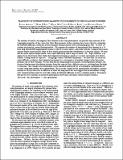Por favor, use este identificador para citar o enlazar a este item:
http://hdl.handle.net/10261/215937COMPARTIR / EXPORTAR:
 SHARE SHARE
 CORE
BASE CORE
BASE
|
|
| Visualizar otros formatos: MARC | Dublin Core | RDF | ORE | MODS | METS | DIDL | DATACITE | |

| Campo DC | Valor | Lengua/Idioma |
|---|---|---|
| dc.contributor.author | Agrawal, Piyush | - |
| dc.contributor.author | Rast, Mark P. | - |
| dc.contributor.author | Gosic, Milan | - |
| dc.contributor.author | Bellot Rubio, Luis R. | - |
| dc.contributor.author | Rempel, Matthias | - |
| dc.date.accessioned | 2020-07-03T09:10:31Z | - |
| dc.date.available | 2020-07-03T09:10:31Z | - |
| dc.date.issued | 2018 | - |
| dc.identifier | doi: 10.3847/1538-4357/aaa251 | - |
| dc.identifier | e-issn: 1538-4357 | - |
| dc.identifier | issn: 0004-637X | - |
| dc.identifier.citation | Astrophysical Journal 854(2): 118 (2018) | - |
| dc.identifier.uri | http://hdl.handle.net/10261/215937 | - |
| dc.description.abstract | The motions of small-scale magnetic flux elements in the solar photosphere can provide some measure of the Lagrangian properties of the convective flow. Measurements of these motions have been critical in estimating the turbulent diffusion coefficient in flux-transport dynamo models and in determining the Alfvén wave excitation spectrum for coronal heating models. We examine the motions of internetwork flux elements in Hinode/Narrowband Filter Imager magnetograms and study the scaling of their mean squared displacement and the shape of their displacement probability distribution as a function of time. We find that the mean squared displacement scales super-diffusively with a slope of about 1.48. Super-diffusive scaling has been observed in other studies for temporal increments as small as 5 s, increments over which ballistic scaling would be expected. Using high-cadence MURaM simulations, we show that the observed super-diffusive scaling at short increments is a consequence of random changes in barycenter positions due to flux evolution. We also find that for long temporal increments, beyond granular lifetimes, the observed displacement distribution deviates from that expected for a diffusive process, evolving from Rayleigh to Gaussian. This change in distribution can be modeled analytically by accounting for supergranular advection along with granular motions. These results complicate the interpretation of magnetic element motions as strictly advective or diffusive on short and long timescales and suggest that measurements of magnetic element motions must be used with caution in turbulent diffusion or wave excitation models. We propose that passive tracer motions in measured photospheric flows may yield more robust transport statistics. © 2018. The American Astronomical Society. All rights reserved. | - |
| dc.description.sponsorship | This paper is based on the data acquired during Hinode Operation Plan 151. We thank the Hinode Chief Observers for their efforts in executing this plan. Hinode was developed and launched by ISAS/JAXA with NAOJ as a domestic partner and NASA and STFC (UK) as international partners. It is operated by these agencies in cooperation with ESA and NSC (Norway). This work has been partially funded by the Spanish Ministerio de Economia y Competitividad through projects ESP2013-47349-C6-1-R and ESP2016-77548-C5-1-R including European FEDER funds. The research has made use of NASA's Astrophysics Data System Bibliographic Services. N.C.A.R. is supported by the National Science Foundation. The authors thank Samuel Van Kooten for magnetic bright points tracking. M.P.R. was partially supported by NASA award NNX12AB35G. P.A. acknowledges the support of the University of Colorado's George Ellery Hale Graduate Student Fellowship. | - |
| dc.language | eng | - |
| dc.publisher | IOP Publishing | - |
| dc.relation | info:eu-repo/grantAgreement/MINECO/Plan Estatal de Investigación Científica y Técnica y de Innovación 2013-2016/ESP2013-47349-C6-1-R | - |
| dc.relation | info:eu-repo/grantAgreement/MINECO/Plan Estatal de Investigación Científica y Técnica y de Innovación 2013-2016/ESP2016-77548-C5-1-R | - |
| dc.relation.isversionof | Postprint | - |
| dc.rights | openAccess | - |
| dc.subject | Sun: granulation | - |
| dc.subject | Sun: photosphere | - |
| dc.title | Transport of Internetwork Magnetic Flux Elements in the Solar Photosphere | - |
| dc.type | artículo | - |
| dc.identifier.doi | 10.3847/1538-4357/aaa251 | - |
| dc.relation.publisherversion | http://dx.doi.org/10.3847/1538-4357/aaa251 | - |
| dc.date.updated | 2020-07-03T09:10:32Z | - |
| dc.contributor.funder | Ministerio de Economía y Competitividad (España) | - |
| dc.contributor.funder | European Commission | - |
| dc.contributor.funder | National Science Foundation (US) | - |
| dc.contributor.funder | National Aeronautics and Space Administration (US) | - |
| dc.contributor.funder | University of Colorado | - |
| dc.relation.csic | Sí | - |
| dc.identifier.funder | http://dx.doi.org/10.13039/100010174 | es_ES |
| dc.identifier.funder | http://dx.doi.org/10.13039/501100000780 | es_ES |
| dc.identifier.funder | http://dx.doi.org/10.13039/501100003329 | es_ES |
| dc.identifier.funder | http://dx.doi.org/10.13039/100000104 | es_ES |
| dc.identifier.funder | http://dx.doi.org/10.13039/100000001 | es_ES |
| dc.type.coar | http://purl.org/coar/resource_type/c_6501 | es_ES |
| item.fulltext | With Fulltext | - |
| item.openairecristype | http://purl.org/coar/resource_type/c_18cf | - |
| item.cerifentitytype | Publications | - |
| item.grantfulltext | open | - |
| item.openairetype | artículo | - |
| Aparece en las colecciones: | (IAA) Artículos | |
Ficheros en este ítem:
| Fichero | Descripción | Tamaño | Formato | |
|---|---|---|---|---|
| IAA_ 2018ApJ...854..118A.pdf | 1,85 MB | Adobe PDF |  Visualizar/Abrir |
CORE Recommender
SCOPUSTM
Citations
8
checked on 20-abr-2024
WEB OF SCIENCETM
Citations
5
checked on 25-feb-2024
Page view(s)
101
checked on 24-abr-2024
Download(s)
107
checked on 24-abr-2024
Google ScholarTM
Check
Altmetric
Altmetric
NOTA: Los ítems de Digital.CSIC están protegidos por copyright, con todos los derechos reservados, a menos que se indique lo contrario.
